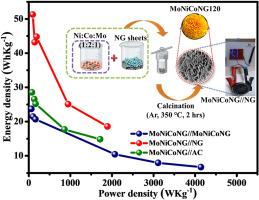N-doped graphene integrated mixed phase Mo-NiCo2O4/CoMoO4 mariegold nanoflowers as positive electrode for high 2 V hybrid supercapacitors
IF 4.9
3区 材料科学
Q2 CHEMISTRY, MULTIDISCIPLINARY
引用次数: 0
Abstract
The quest for high-performance supercapacitor materials with extended potential windows and superior energy storage capabilities has driven the exploration of ternary transition metal oxide nanostructures. In this work, a novel mixed-phase Mo-NiCo2O4/CoMoO4 composite anchored on nitrogen-doped graphene (NG) sheets was synthesized via a one-step hydrothermal approach. The NG sheets act as active substrates that not only facilitate the intimate growth of Mo, Ni and Co on nucleation sites but also influence the growth kinetics, leading to the formation of intricate marigold-like nanoflowers assembled from wavy lamellar nanosheets consisting of Mo-NiCo2O4/CoMoO4. The unique heterojunctioned structures result in a mesoporous MoNiCoNG120 composite with high surface area and dense electroactive sites, achieving a remarkable specific capacitance of 280.40 Fg-1 at 0.30 Ag-1. To evaluate its device-level performance, symmetric (MoNiCoNG//MoNiCoNG) and asymmetric (MoNiCoNG//NG and MoNiCoNG//AC) supercapacitors were assembled. The MoNiCoNG//NG asymmetric device exhibited a high energy density of 51.28 Whkg−1 and power density of 96.40 W kg−1 at 0.08 A g−1 retaining ∼80 % capacitance retention after 5000 charge-discharge cycles. The device successfully powered a 14-LED circuit for over 3 min using the cells assembled in series combination. These results highlight the potential of the MoNiCoNG composite as a next-generation electrode material for high-energy supercapacitors.

n掺杂石墨烯集成混合相Mo-NiCo2O4/CoMoO4婚金纳米花作为高2v杂化超级电容器的正极
对具有扩展潜在窗口和卓越储能能力的高性能超级电容器材料的追求推动了三元过渡金属氧化物纳米结构的探索。在这项工作中,通过一步水热法合成了一种新型的固定在氮掺杂石墨烯(NG)片上的混合相Mo-NiCo2O4/CoMoO4复合材料。NG片作为活性底物,不仅促进Mo, Ni和Co在成核位点的紧密生长,而且影响生长动力学,导致由Mo- nico2o4 /CoMoO4组成的波浪片状纳米片组装成复杂的万金菊状纳米花。独特的异质结结构使介孔MoNiCoNG120复合材料具有高表面积和密集的电活性位点,在0.30 Ag-1时达到280.40 Fg-1的显着比电容。为了评估其器件级性能,组装了对称(MoNiCoNG//MoNiCoNG)和非对称(MoNiCoNG//NG和MoNiCoNG//AC)超级电容器。在0.08 a g−1下,MoNiCoNG//NG非对称器件的能量密度高达51.28 Whkg−1,功率密度高达96.40 W kg−1,在5000次充放电循环后,电容保持率高达80%。该器件使用串联组合的电池成功地为14个led电路供电超过3分钟。这些结果突出了MoNiCoNG复合材料作为下一代高能超级电容器电极材料的潜力。
本文章由计算机程序翻译,如有差异,请以英文原文为准。
求助全文
约1分钟内获得全文
求助全文
来源期刊
CiteScore
7.80
自引率
2.50%
发文量
605
审稿时长
40 days
期刊介绍:
The Journal of Physics and Chemistry of Solids is a well-established international medium for publication of archival research in condensed matter and materials sciences. Areas of interest broadly include experimental and theoretical research on electronic, magnetic, spectroscopic and structural properties as well as the statistical mechanics and thermodynamics of materials. The focus is on gaining physical and chemical insight into the properties and potential applications of condensed matter systems.
Within the broad scope of the journal, beyond regular contributions, the editors have identified submissions in the following areas of physics and chemistry of solids to be of special current interest to the journal:
Low-dimensional systems
Exotic states of quantum electron matter including topological phases
Energy conversion and storage
Interfaces, nanoparticles and catalysts.

 求助内容:
求助内容: 应助结果提醒方式:
应助结果提醒方式:


